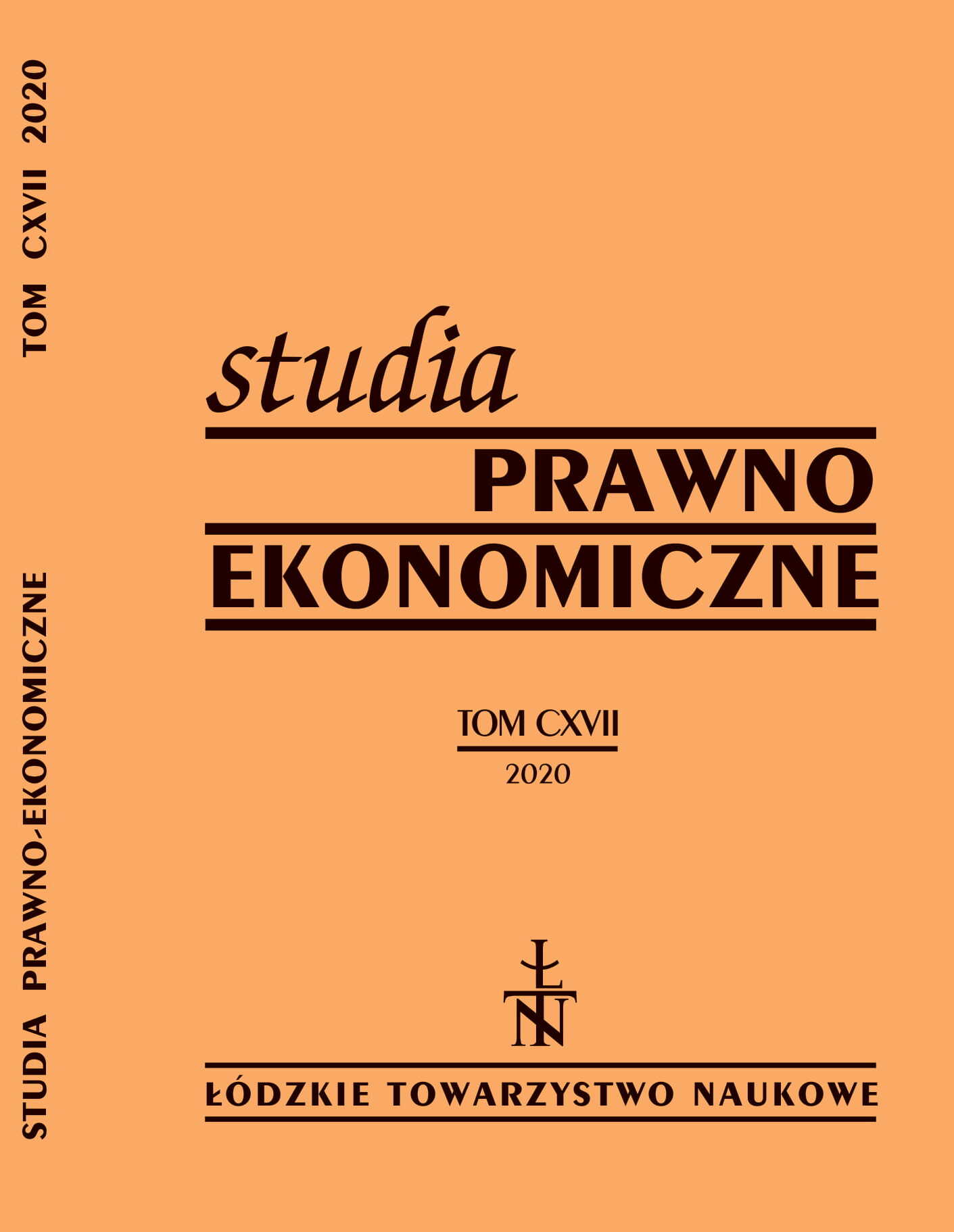The assessment of use of the traditional monetary transmission mechanism by the National Bank of Poland in 2014–2018
DOI:
https://doi.org/10.26485/SPE/2020/117/14Keywords:
investments, money supply, Gross Domestic Product, interest rates, traditional monetary transmission mechanismAbstract
Background: One of the main factors conditioning effective communication of the central bank with entities of real and financial spheres is the rational use of specific channels for the propagation of monetary impulses. The most common “type of communication” of that is the interest rate channel. These interest rates are the most important component of the so-called “traditional monetary transmission mechanism”, which – in theoretical terms – assumes that the lowering of market interest rates by the Monetary Policy Council should stimulate the socio-economic development of state, manifested by increase: money in circulation (money supply), size of investments and level of Gross Domestic Product.
Research purpose: The aim of this article was to examine the effectiveness of using traditional monetary transmission mechanism by the National Bank of Poland in 2014–2018, as well as to determine the degree of correlation between interest rates and other components of this mechanism.
Methods: The possibility of achieving the indicated objective was conditioned by carrying out a specific research procedure, based on – firstly – showing the nominal values of individual components of the traditional monetary transmission mechanism, secondly – determining the medium-term rate of change of these quantities, and – thirdly – calculating the values of linear correlation coefficients Pearson and linear determination, on the basis of which were examined strength and direction of correlations between value of interest rates (lombard, rediscount, reference and deposit) and the level of Gross Domestic Product, investments and money supply. Due to the fact that the detailed scope of empirical data necessary to conduct the research is collected and published by the National Bank of Poland and the Central Statistical Office, the study is based on secondary data from the reports of the aforementioned institutions.
Conclusions: The results obtained in the course of the calculation procedure indicate that in the years 2014–2018 the National Bank of Poland rationally used the interest rate channel. The decisions of the Monetary Policy Council regarding the reduction of the level of short-term interest rates resulted in growth of: money supply, investments and Gross Domestic Product. It should be noted that between the economic measures there was a very strong (interest rates and money supply), a strong (interest rates and Gross Domestic Product) or – at least – a moderate (interest rates and investments) degree of correlation with minus direction. This means that in the period covered by the study, the National Bank of Poland effectively used the traditional monetary transmission mechanism.
References
Uchwała Rady Polityki Pieniężnej z dnia 4 września 2018 roku w sprawie ustalenia założeń poli¬tyki pieniężnej na rok 2019 (M.P. z 2018 r., nr 5, poz. 925).
Arestis P., Sawyer M., Interest Rates and the Real Economy, w: C. Gnos, L.P. Rochon (red.), Post-Keynesian Principles of Economic Policy, Edward Elgar, Chaltenham, Northampton, Massachusetts 2006, s. 3–20.
Baumgartner E., Jak działa giełda? Podręcznik dla inwestorów, Polpress Services, Nowy Jork 2007.
Bean C., Larsen J., Nikolov K., Financial Frictions and the Monetary Transmission Mecha¬nism: Theory, Evidence and Policy Implications, Working Paper 2002/113, s. 1–67.
Brózda D., Strukturalne uwarunkowania mechanizmu transmisji monetarnej w Polsce i strefie euro, Zeszyty Naukowe Uniwersytetu Szczecińskiego 2013/756, s. 61–75.
Demchuk O., Łyziak T., Przystupa J., Sznajderska A., Wróbel A., Mechanizm transmisji po¬lityki pieniężnej w Polsce. Co wiemy w 2011 roku?, Materiały i Studia 2012/270, s. 1–63.
Fojcik-Mastalska E., Bank centralny, w: J. Głuchowski (red.), System prawa finansowego. Tom IV. Prawo walutowe. Prawo dewizowe. Prawo rynku finansowego, Oficyna a Wolters Klu¬wer business, Warszawa 2010, s. 99–140.
Frączkiewicz K., Skup i sprzedaż wierzytelności przez banki, Promotor, Warszawa 2007.
Grzyb M., Obligacje komunalne i kredyty bankowe jako zwrotne źródła finansowania gmin w Polsce w latach 2012–2016, w: A. Wójcik-Mazur, J. Łukomska-Szarek (red.), Współcze¬sne problemy zarządzania finansami – teoria i praktyka, Wydawnictwo Wydziału Zarządza¬nia Politechniki Częstochowskiej, Częstochowa 2018, s. 7–18.
Jarnuszkiewicz K., Analiza wpływu kryzysu gospodarczego lat 2007–2009 na polski rynek kapi¬tałowy, w: K. Woźniak (red.), Narzędzia analityczne w naukach ekonomicznych, Mfiles.pl, Kraków 2015, s. 87–92.
Kaźmierczak A., Polityka pieniężna w gospodarce otwartej, Wydawnictwo Naukowe PWN, Warszawa 2008.
Kaźmierczak A., Polityka pieniężna w gospodarce rynkowej, Wydawnictwo Naukowe PWN, Warszawa 2003.
Kokoszczyński R., Łyziak T., Wróbel E., Czynniki strukturalne we współczesnych teoriach me¬chanizmów transmisji polityki pieniężnej, Bank i Kredyt 2002/11, s. 41–48.
Lewandowska J., Mechanizm transmisji impulsów polityki monetarnej dla polskiej gospodarki w latach 2002–2015, w: A. Prędki (red.), Metody analityczne w naukach ekonomicznych – wybrane zastosowania, Fundacja Uniwersytetu Ekonomicznego w Krakowie, Kraków 2016, s. 111–122.
Matusiak J., Peryferyjny kapitalizm zależny, LaTeX, Warszawa 2015.
Niczyporuk P., Talecka A., Bankowość. Podstawowe zagadnienia, Temida 2, Białystok 2011.
Owsiak S., Bank centralny, w: M. Zaleska (red.), Bankowość, C.H. Beck, Warszawa 2013.
Przekota G., Reakcja rynkowych stóp procentowych na zmiany stopy redyskonta weksli, Zeszyty Naukowe Wydziału Nauk Ekonomicznych Politechniki Koszalińskiej 2010/14, s. 93–105.
Schmolke H., The Low Interest Rate Policy of the European Central Bank, Anchor Academic Publishing, Hamburg 2017.
Słownik Reutera: międzynarodowe terminy ekonomiczne i finansowe, oprac. Zespół Reuters Limi¬ted. Powszechna Agencja Informacyjna, Warszawa 1992.
Szunke A., Polityka pieniężna a stopa bezrobocia. Wzajemne zależności i powiazania, w: J. Osiń¬ski (red.), Praca, społeczeństwo, gospodarka. Między polityką a rynkiem, Oficyna Wydaw¬nicza Szkoła Główna Handlowa w Warszawie, Warszawa 2011, s. 95–106.
Teichert M., The interest rate risk of banks. Current topics, Würzburg University Press, Würz¬burg 2018.
https://businessinsider.com.pl/finanse/makroekonomia/polska-z-najnizsza-stopa-inwestycji-od- 1996-r/6h6r1tb; stan na 30.03.2020 r.
https://www.nbp.pl/home.aspx?f=/publikacje/operacje_or/raport_operacje_or.html; stan na 30.03.2020 r.
https://www.nbp.pl/home.aspx?f=/statystyka/instrumenty/instrumenty.html; stan na 30.03.2020 r.
https://www.nbp.pl/statystyka/pieniezna_i_bankowa/dwn/podaz_bilansowa.xlsx; stan na 30.03.2020 r.
https://www.obserwatorfinansowy.pl/tematyka/makroekonomia/inwestycje-firm-w-polsce-przyspiesza-dzieki-efektowi-wpychania/; stan na 30.03.2020 r.
https://stat.gov.pl/obszary-tematyczne/roczniki-statystyczne/; stan na 30.03.2020 r.







